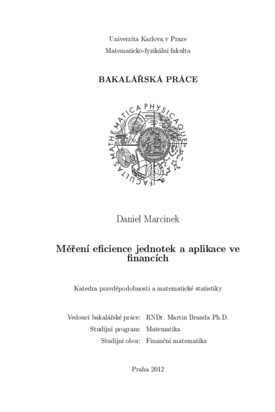Měření eficience jednotek a aplikace ve financích
Data Envelopment Analysis with financial application
bakalářská práce (OBHÁJENO)

Zobrazit/
Trvalý odkaz
http://hdl.handle.net/20.500.11956/40598Identifikátory
SIS: 113182
Katalog UK: 990014991340106986
Kolekce
- Kvalifikační práce [11978]
Autor
Vedoucí práce
Oponent práce
Zichová, Jitka
Fakulta / součást
Matematicko-fyzikální fakulta
Obor
Finanční matematika
Katedra / ústav / klinika
Katedra pravděpodobnosti a matematické statistiky
Datum obhajoby
5. 9. 2012
Nakladatel
Univerzita Karlova, Matematicko-fyzikální fakultaJazyk
Čeština
Známka
Výborně
Klíčová slova (česky)
analýza obalu dat, eficience, míry rizika, podílové fondyKlíčová slova (anglicky)
Data Envelopment Analysis, efficiency, risk measures, mutual fundsPráce pojednává o různých metodách analýzy obalu dat a jejich využití ve financích. Efektivita se měří pomocí poměru vážených výstupů ku váženým vstupům. Z tohoto předpokladu se formuluje úloha lineárního lomeného programování, která se transformuje na úlohu lineárního programování. Pro ní odvodíme úlohu duální. Také zavedeme další metody analýzy obalu dat. Vysvětlíme rozdíl mezi konstantními výnosy z rozsahu a variabilními výnosy z rozsahu. Zabýváme se mírami rizika, které jsou spolu se správními poplatky vstupy pro naší úlohu. Jako výstupy jsme použili hrubé výnosy. Sestavené modely jsme otestovali na 15-ti podílových fondech, určili eficienci těchto fondů a metody mezi sebou porovnali. Nakonec jsme vyhodnotili jaký vliv na efektivitu má užití pouze měr rizika jako vstupů.
This thesis deals with various methods of Data Envelopment Analysis and their use in finance. Efficiency is measured by a ratio of weighted outputs to weighted inputs. From this model, a fractional programming problem is formed, which is then transformed into a linear programming problem. We derive a dual problem for that one. We also introduce another methods of Data Envelopment Analysis. We explain difference between a constant return to scale and a variable return to scale. We deal with a risk measures, which are considered as the inputs together with the management fees. We use gross returns as the single input. We apply these models to 15 mutual funds, determine efficiency of these mutual funds and compare these methods with another one. At the end we determine how the efficiency changes if we use only the risk measures as the inputs.
